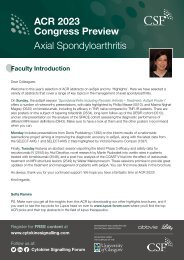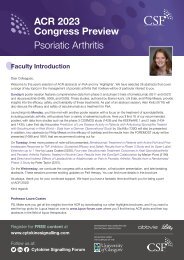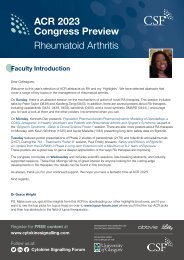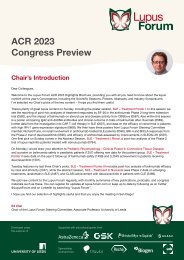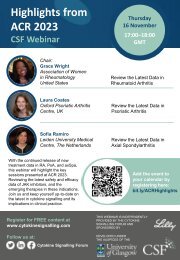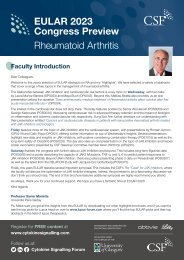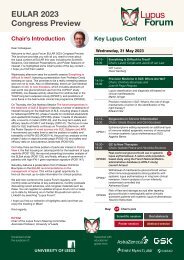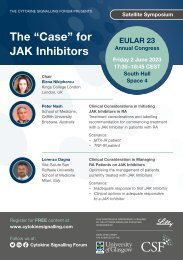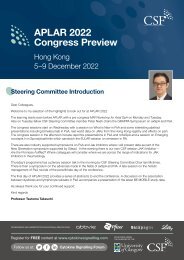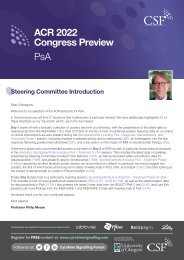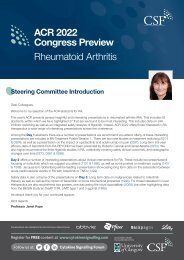non-melanoma skin cancer) incidence rates were 0.8 (2 mg) and 1.0 (4 mg; as-randomised analysis). In summary, baricitinib maintained a safety profile similar to that previously reported and acceptable in the context of demonstrated efficacy [847*]. Filgotinib Filgotinib safety in the FINCH programme Pooled safety data from the double-blind, active and placebo-controlled periods of FINCH 1–3 up to 24 weeks were presented by Winthrop and colleagues. The FINCH studies enrolled patients who had a diagnosis of RA (2010 <strong>ACR</strong>/EULAR criteria) and had ≥ 6 swollen joints and ≥ 6 tender joints at both screening and Day 1. The pooled safety analyses included 3,452 patients across FINCH 1–3, including 2,088 patients who received filgotinib. At Week 24, the frequency of TEAEs was similar between patients who received filgotinib and those in the control arms. The proportions of patients with TEAEs of interest were also similar across groups. Overall, the frequency of MACE, herpes zoster virus, DVT and PE was low, and similar across groups. The incidences of MACE were 0.2% for filgotinib, 0.3% for adalimumab, and 0.5% for placebo/csDMARD. Additionally, the incidences of DVT/PE were
In the first presentation, the analyses included a total of 1544 tofacitinib (2138.2 patient years) and 7083 bDMARD (9904.9 patient years) initiators. Rates of MACE and serious infection events were similar in patients starting tofacitinib or bDMARDs for RA. The herpes zoster incidence rate was higher for tofacitinib versus bDMARDs and hazard ratios (HR) for herpes zoster were significantly increased with tofacitinib versus bDMARDs (adjusted HR 2.12, 95% CI: 1.22, 3.66). All herpes zoster events were nonserious with tofacitinib. VTE IRs were similar in both cohorts [2372]. In a second presentation, the authors compared 5-year IRs of malignancy and mortality in a total of 1999 tofacitinib (4505.62 PY) and 6354 bDMARD (16670.84 PY) initiators. RA patients initiating tofacitinib or bDMARDs had similar rates of total cancer excluding NMSC, NMSC, and death, with adjusted HRs (95% CI) of 1.04 (0.68, 1.61), 1.02 (0.69, 1.50), and 1.0 (0.62, 1.63), respectively [2874*]. Risk of serious infections with tofacitinib A poster presenting the comparative incidence rates of serious bacterial, viral or opportunistic infections in RA patients was presented by Pawar and colleagues. Using data from three US healthcare claims databases, a total of 123,960 biologic initiators were identified, of which 4.5% were tofacitinib initiators. A total of 2,958 serious infection events occurred. In the tofacitinib group, the crude IR for serious infections per 100 person-years ranged from 2.80 (MarketScan) to 7.89 (Medicare). Adjusted HRs showed higher risk of composite serious infections with tofacitinib compared with abatacept (HR 1.20, 95% CI 1.09-1.31), etanercept (1.27, 1.14-1.42), golimumab (1.35, 1.29-1.40) and tocilizumab (1.46, 1.31-1.63), but similar risk compared to adalimumab, certolizumab and infliximab. Serious bacterial infection risk was higher in tofacitinib than abatacept (1.15, 1.09-1.21), certolizumab (1.16, 1.10-1.23), etanercept 1.14 (1.04-1.25) and golimumab (1.21, 1.06-1.39) [2826]. Vinet and colleagues presented results from a study comparing the risk of serious infections in children born to mothers with chronic inflammatory diseases who used non-TNFi biologics or tofacitinib during pregnancy, versus unexposed offspring and children exposed to TNFi in utero. The US MarketScan database was used to identify 16,490 offspring of mothers with RA (4,142), AS (381), PsO/PsA (5,743), and inflammatory bowel disease (6,731), as well as 164,553 children born to unaffected mothers matched for age, year of delivery and state of residence. Very few serious infections were detected in children exposed to non-TNFi biologics or tofacitinib (2 cases [1.9%]: one case was exposed to tofacitinib, while the other was exposed to abatacept). The percent of serious infections in offspring of inflammatory disease mothers with no TNFi exposure was 2.1%, while for those with TNFi in utero exposure, it was 2.3%. In children born to unaffected mothers, the percent of serious infections was 1.6% [1901]. Baricitinib Post-marketing surveillance of baricitinib safety in RA A poster presenting baricitinib safety based on post-marketing surveillance data was presented by Matsuno and colleagues. This interim report summarized registration data including pre-treatment test rates and AEs. As of August 2018, 1288 patients had been enrolled. Registration data were reported as follows: women, 81%; mean age, 64 years old; mean RA duration, 12 years; Steinbrocker stage II, 32%; stage III or IV, 52%; baricitinib 4 mg, 68%; baricitinib 2 mg 32%; MTX use, 57%; corticosteroid use, 51%; pre-treatment test for tuberculosis, 93%; HBV, 95%; HCV, 93%; and eGFR, 96%. Of 299 AEs collected, 53 were SAEs. SAEs reported in 2 or more patients were pneumonia (n=8), fall (n=4), osteonecrosis (n=3), herpes zoster (n=2) and interstitial lung disease (n=2). Pulmonary TB (n=1), lymph node TB (n=1) and DVT (n=1) were also reported as SAEs. Overall, safety findings were consistent with baricitinib’s known safety profile. These data highlight that care is needed to ensure that all pre-treatment tests are conducted in all patients [2375]. *Chairman’s Pick



